LEGION OF SUPER-HEROES
The Animated Legion

The Legion of Super-Heroes starred in their own animated series for two seasons, which ran from September 2006 to April 2008. Prior to that, Legionnaires made various guest appearances in two other DC cartoons. The continuity between these series is debatable, and cannot be definitively linked.
However, the "DC animated universe" was mostly masterminded by Bruce Timm and Paul Dini, who delivered a consistent look and tone across all series: Batman: The Animated Series, Superman: The Animated Series, Batman Beyond and Justice League. So it's reasonable to expect some similarities among the characters (especially supporting characters), because they shared creators and animators.
But the visual style of the Legion series was a departure from those previous cartoons. And series creator James Tucker denied that these universes were connected by saying: "The Legion series was never tied to the Justice League Unlimited episode (below). Supergirl was never, ever going to be in the Legion."
This article explores the Legion's animated appearances without attempting to hammer them into a logical continuity. The chronology that follows focuses on the events contained within the Legion of Super-Heroes animated series and related comic book, Legion of Super-Heroes in the 31st Century.
Superman: The Animated Series (1998)



Superman: The Animated Series
The Legion made their first cartoon appearance on Superman: The Animated Series in an episode titled "New Kids In Town" (season 3, episode 3, 31 Oct. 1998). Cosmic Boy, Saturn Girl, and Chameleon Boy intercepted Brainiac in the 20th century, where he had engaged with teenage Clark Kent. They told him about his destiny as Superman, and an aside showed a group of Legionnaires, including Ultra Boy, Apparition, Dream Girl, Live Wire, Spark, Brainiac 5, Triad, Bouncing Boy, Kid Quantum and Andromeda.
In the Superman series, Brainiac was depicted with a three-circle symbol on his head. This motif was inspired by his classic comic book look. (Also, the same actor, Corey Burton, voiced Brainiac in both Superman and the finale of Legion.) This symbol reappeared on Brainiac 5 in this episode and in his next animated appearance (see below). The android Brainy of the Legion animated series sported the same.
At this time in DC publishing, Legion comic books featured the post-Zero Hour Legion, and so the Legionnaires depicted in this cartoon mirror the look of those characters, though they do not map exactly to the members at that time.
Justice League animated universe
The following appearances do not necessarily all fit within the same continuity, but they are in the style of the Justice League animated series.
Adventures in the DC Universe #10 (Jan. 1998)

A Legion cruiser carrying a large group of Legionnaires is caught in the tractor beam of an amorphous space-blob. Saturn Girl eventually ascertains that it is a sort of "galactic antibody" that perceives them as germs. As she learns more, she realizes the truth... Sensor has been unconscious from their most recent battle and has been subconsciously creating the whole incident in their minds.
Meanwhile, at Legion headquarters, their distress call fails to make it through. Brainy's lab is invaded by the super-burglar Magpie, Benn Pares. The newest Legionnaire, Ferro, helps to bring him down.
Notes
While this story does not feature the Justice League, stories from the Adventures in the DC Universe series are presented in the style of that animated series. The Legion in this comic book story is based on the Reboot team, which does not have any parallels to any Legion cartoon appearances.
This story could actually sit within mainstream Reboot continuity. It fits after the team's reunion in Legion vol. 4 #100 (Jan. 1998). The Legionnaires include Gates, Kinetix and Sensor, they make reference to the White Triangle battle. Pretty much every active Legionnaires puts in an appearance.
Legion of Super-Heroes vol. 4 #100 (Jan. 1998)

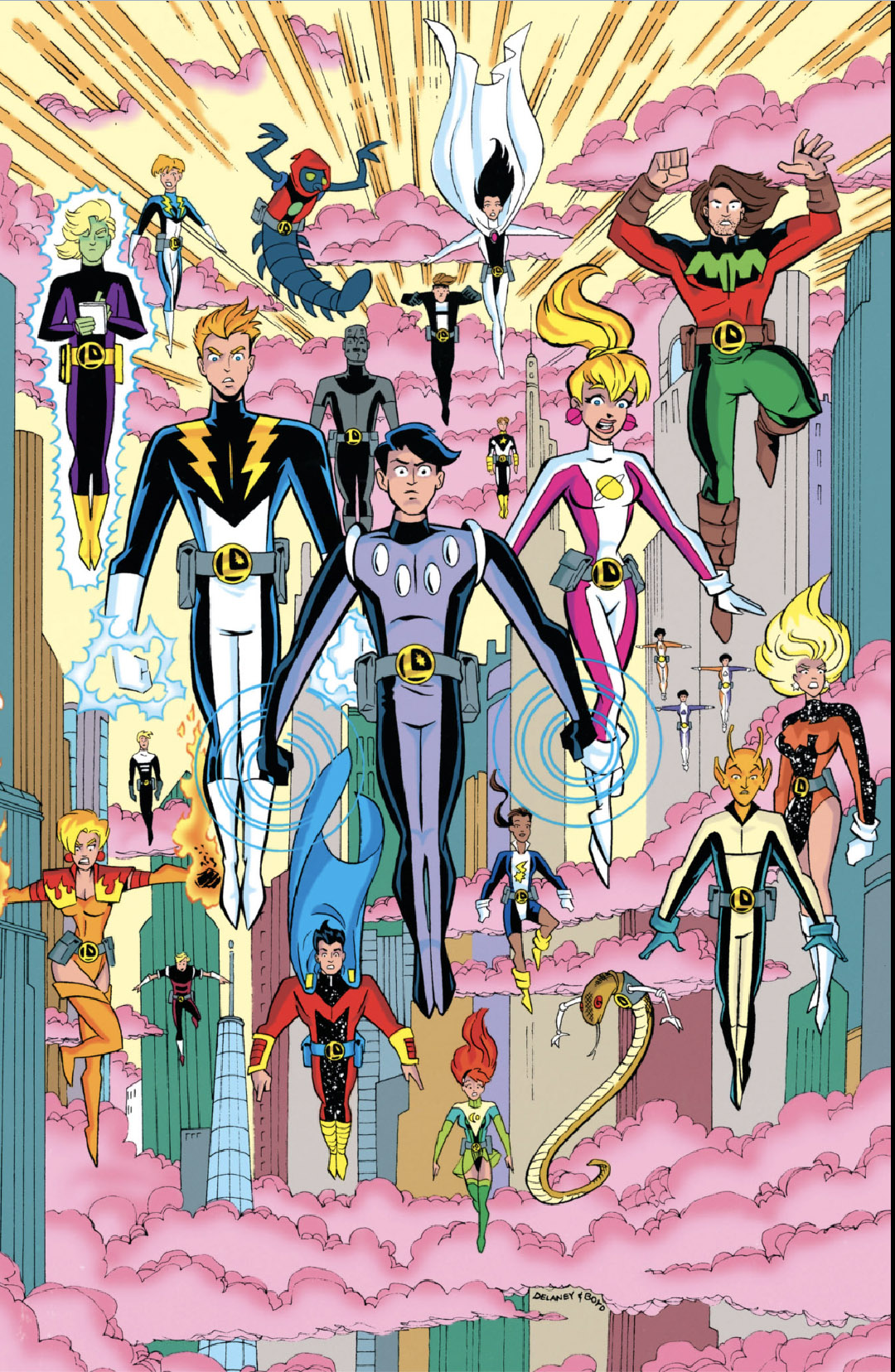
In an episode of "The Brainiac Adventures," Brainiac 5 dreams of a time when the Time Trapper turns the Legionnaires into children in a "super-hero club."
This issue also features a team pin-up in the "Adventures" style.
Justice League Adventures #28 (Apr. 2004)

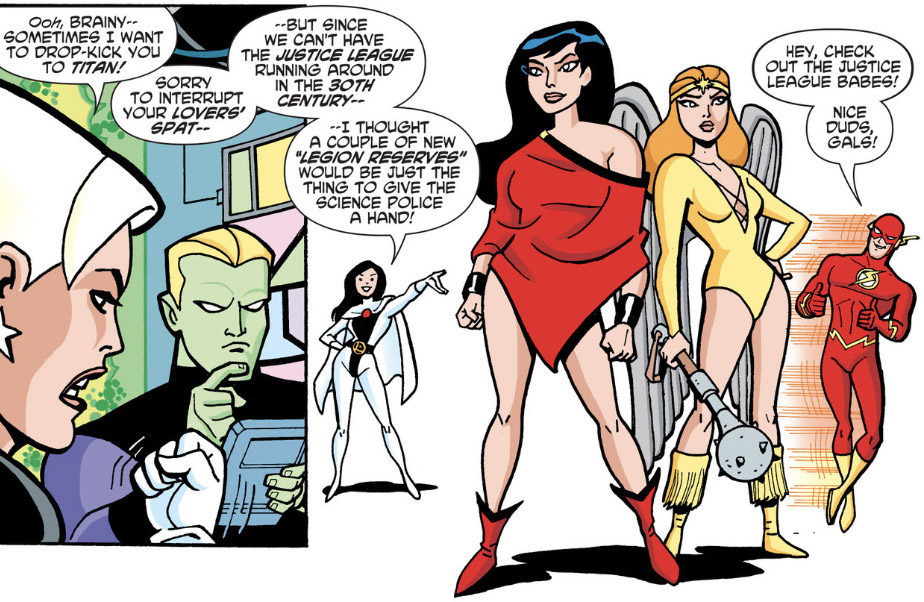
When the Justice League encounters the artifical intelligence called Kilg%re, they are hijacked into the year 2980. There they meet the Legionnaires Andromeda, Brainiac 5 and Kid Quantum and Phantom Girl. The Kilg%re is defeated with Brainiac 5's creation, Computo.
Other Legion characters appear, including reporter Kent Shakespeare, Science Police officer Shvaughn Erin and two Legion reserve members.
One reservist is modeled on Laurel Kent, but instead of being a descendent of Superman, she is unnamed and exclaims, "Hera!" suggesting an Amazonian lineage. The other is called Hawkgirl, a character clearly modeled on Dawnstar but also a descendant of the 21st century Hawkgirl.
Justice League Unlimited (2006)



A different-looking Legion appeared in "Far from Home" (Justice League Unlimited season 3, episode 10, 15 April 2006), where Supergirl, Green Lantern and Green Arrow meet Brainiac 5 and Bouncing Boy. The League helps defeat the Fatal Five and free the rest of the Legionnaires. Supergirl then elects to remain in the future.
The appearance of Brainiac 5 here is quite different from the character's later cartoon appearances. In JLU, Brainy is quite humanoid, but in Legion, he is an android like his 21st century namesake.
Validus is depicted here as a robot with a brain; in the Legion of Super-Heroes cartoon, he is fully biological.
The Legionnaires and Legion headquarters in this episode are very similar to those in the Superman episode above. The shot of Legion HQ was copied entirely, and Chameleon Boy, Cosmic Boy and Saturn Girl are drawn essentially the same.
The JLU episode "The Greatest Story Never Told" (season 1, episode 7), featured the Legion's arch-foe, Mordru, running rampant in 20th century Metropolis. His depiction is in line with his original comic appearances, though there was no real context given for his appearance here, without the Legion.
Batman Beyond
There is a chain of connections linking the Legion animated series to the Batman Beyond universe. It begins with the character Warhawk, who was introduced in "The Call" (Batman Beyond, 2000). Warhawk was later revealed to be the child of Green Lantern (John Stewart) and Hawkgirl (Shayera Hol), characters from the Justice League animated series. Warhawk and Terry McGinniss ("Batman Beyond") appeared twice in the JLU cartoon: "The Once and Future Thing" and "Epilogue" (2005).
Later, future versions of the Warhawks appeared in the Legion animated comic book, Legion of Super-Heroes in the 31st Century #17 (Oct. 2008).
Batman Beyond was assigned to Earth-12 in the DC multiverse, a designation given in Countdown #21 (2007) and The Multiversity Guidebook (Mar. 2015). The animated Justice League could also be Earth-12, but that has never been explicitly stated.
Legion of Super-Heroes animated series (2006–2007)

The first season of the Legion of Super-Heroes animated series focused on a group of seven Legionnaires — Brainiac 5, Bouncing Boy, Lightning Lad, Phantom Girl, Saturn Girl, Timber Wolf and Triplicate Girl — plus Superman.
The animation style of this cartoon was more inspired by anime, a departure from the previous DC series. At the start, it's made clear that the Legion has many members. The opening sequence shows many of them, and their graphic symbols appear as well. Later in the series, the group's traditional origin is told, but the order in which all the other Legionnaires joined is uncertain.



During the course of the show, many more Legionnaires are introduced and some of them join the team.
A related comic book, Legion of Super-Heroes in the 31st Century, wove its stories in between episodes.
Season Two took a leap three years forward in time, and a number of things had changed. It introduced the character of Kell-El aka Superman X. The animation style evolved as well. Characters were rendered in a more serious style and the show itself took a darker tone.
The Legion animated series was not renewed for a third season because the "Kids' WB!" was sold. The show's creators went on to produce Batman: The Brave and the Bold for Cartoon Network.
Producer James Tucker said to CBR:
"Initially when we were pitching second season, we had planned to introduce a character that was like Superman's older or twin brother. The network, rightly so, didn't think it would pop. They wanted a super-up Superman. They didn't care how we did it, but they wanted him to be more of a bad ass. For me, I didn't want to alter our existing Superman that much. So along with Michael Jelenic, we came up with the clone from the future."
When the last animated episode was written, the creators did not know it would be the series final. Writer J. Torres mentioned wanted to introduce the LSV, "Most importantly, we wanted to show where Brainy went after the end of season two and how he made his way back to the Legion... While we were waiting to hear the fate of the show, we basically just 'skipped ahead' and started writing stories as if we were in a third season."
James Tucker mentioned some potential introductions for the Season 3 cartoon: Wildfire, Dawnstar, Ferro Lad's brother, and a spotlight on Blok.
Issues #17–20 of the comic book series take place after the final episode of the cartoon.
» SEE ALSO:
JLA Adventures: Trapped in Time (2014)
JLA Adventures: Trapped in Time is a feature-length, direct-to-video animated film. It features Dawnstar and Karate Kid in prominent roles.

The story centers around the present day Justice League, and their battle against the Lex Luthor's Legion of Doom. After theif defeat, Luthor is placed in suspended animation and eventually becomes an exhibit in a museum in the 31st century. There he is accidentally released by two Legionnaires-in-training, Dawnstar and Karate Kid. Luthor steals a powerful hourglass and unleashes the Time Trapper. They return to the 21st century and the young heroes follow.
Luthor uses his new power to alter the timeline and eliminate Superman. Dawnstar and Karate Kid then create a time paradox by ensuring that Lex Luthor never goes into suspended animation. This frees the Time Trapper from Luthor's control and the entity attacks.
Karate Kid's ingenuity and Dawnstar's light-based powers manage to reimprison the Trapper. The Justice League invites Karate Kid and Dawnstar to stay with them but they return to the 31st century — where they discover that history has changed and Lex is a legendary hero! Rather than investigate any further, they immediately return to the 21st century.
Justice League vs. the Fatal Five (2019)






Justice League vs. the Fatal Five is a 2019 feature-length animated movie set in the same universe as the Justice League animated series. The Legion's depiction seems to also be in line with their appearance on that show (see above). The tone of this feature is more adult than the original cartoon; characters use swear words and actually kill people. The film features outstanding action sequences and a compelling narrative.
The featured Legionnaire in this story is Star Boy. The story borrows a plot point from the character's treatment in the 2007 Justice Society series: he has a mental condition that requires periodic injections to stabilize his mind; without them he cannot think straight and his condition may worsen permanently. (As Starman, he was a member of the JSA from Justice Society of America vol. 3 #1–23.) In this feature, Star Boy is called "Thomas" not "Thom," and wears his uniform from the 1980s with the starfield and white gloves (but no beard). A photo suggests that he has a relationship with Lightning Lass.
The story's origins begin with a 31st century fight between the Legion and the Fatal Five. The villains nearly triumph and the Emerald Empress' Emerald Eye struck down even their most powerful member, Mon-El. It succumbed to Star Boy's extreme weight shifting ability while Saturn Girl mentally incapacitated the Five.
After a battle, the Emerald Empress and Validus are imprisoned in "sciencells" on Oa (the Green Lantern Corps' base of operations). The remaining members (Mano, Tharok and the Persuader) escape. Note: Their imprisonment is a curious hiccup in plot continuity because it is said that in the 31st century, the Green Lantern Corps has been "lost to the ages."
Mano is in love with the Emerald Empress and devises a plan to steal the Legion's Time Bubble. They seek a "key" to release their teammates. Since there are no Green Lanterns in their time, they need to find one in the past. A year later, they attack Legion headquarters and gain access to the machine. Star Boy, Brainiac 5 and Saturn Girl fail to stop them but Star Boy jumps into the timestream after them. They emerge in the time of the Justice League in the 21st century.
After arriving, Star Boy's mental condition deteriorates. He is found by Batman and placed in Arkham Asylum. Meanwhile the Fatal Five remain trapped in stasis inside the Bubble but they are released when it is examined by Mister Terrific at the headquarters of the Justice League. The League (Wonder Woman, Superman, Batman and Miss Martian) succumb to the villains, who escape and search for their "key" — the new Green Lantern, Jessica Cruz.
Mano coerces Jessica into helping them, to stem further violence and destruction. They go to Oa to free the Empress and Validus. The Emerald Eye absorbs power from the Lanterns' central power battery. Note: It is not explained how they exist in the 21st century if they had been captured in the 31st. Perhaps the cells exist simultaneously in all times.
Before they return to the 31st century, the Empress decides to use the Eye's new power to destroy Earth's sun — in order to destroy the planet's future. The next battle destroys the Justice League's mountain headquarters and Superman, Star Boy and Jessica go to intercept the Emerald Eye at the sun. Superman fails and Star Boy must enter the sun and use his gravity powers to hold the star together. He presumably dies and the Justice League holds a memorial for him. Seven Legionnaires arrive from the future to attend.
The fate of the Fatal Five is unrevealed; they are last seen buried under the collapsed mountain.
Notes
When Miss Martian takes the Justice League inside Star Boy's mind, they learn more about the Legion and Fatal Five. In Legion headquarters they see tribute statues to the Justice League and statues of the Legionnaires. Some are not definitively identifiable, but they include Night Girl and Stone Boy.
Brainiac 5 is depicted in a manner very similar to his uniform in "Far From Home."
Chameleon Boy appears in the same costume as his first cartoon appearance, on Superman.
Hawkgirl has returned to Thanagar and there is mention of a war there.
Miss Martian is a trial member, and awarded full membership at the conclusion of the case.
In the future, it's said that Jessica Cruz will attain legendary status as "Limelight."
Young Justice: Phantoms



The Legion guest-starred in the fourth season of Young Justice, on HBOMax.
Their presence was teased by the appearance of a Legion flight ring in the finale of Season 3 — Young Justice: Outsiders episode 26, "Nevermore" (27 Aug. 2019).
Saturn Girl, Phantom Girl and Chameleon Boy then appeared in season 4, watching Superboy (Kon-El) on Mars in the 21st century. (“Volatile,” S4 E3, 21 Oct. 2021) Superboy and Phantom Girl apparently died in the next episode. (S4 E4)
Saturn Girl and Chameleon Boy ultimately reached out to Impulse (Bart Allen) on Earth and told them their story. In the 31st century, the prisoners of the Phantom Zone were paroled by the United Planets. They were settled on the planet Daxam, but Zod eventually menaced the galaxy. The newly-formed Legion reimprisoned the Kryptonians. But Zod's son, Lor, remained free and took revenge by going to the 21st century to kill the Legion's inspiration, Superboy. (S4 E19)
Legion of Super-Heroes feature (2023)
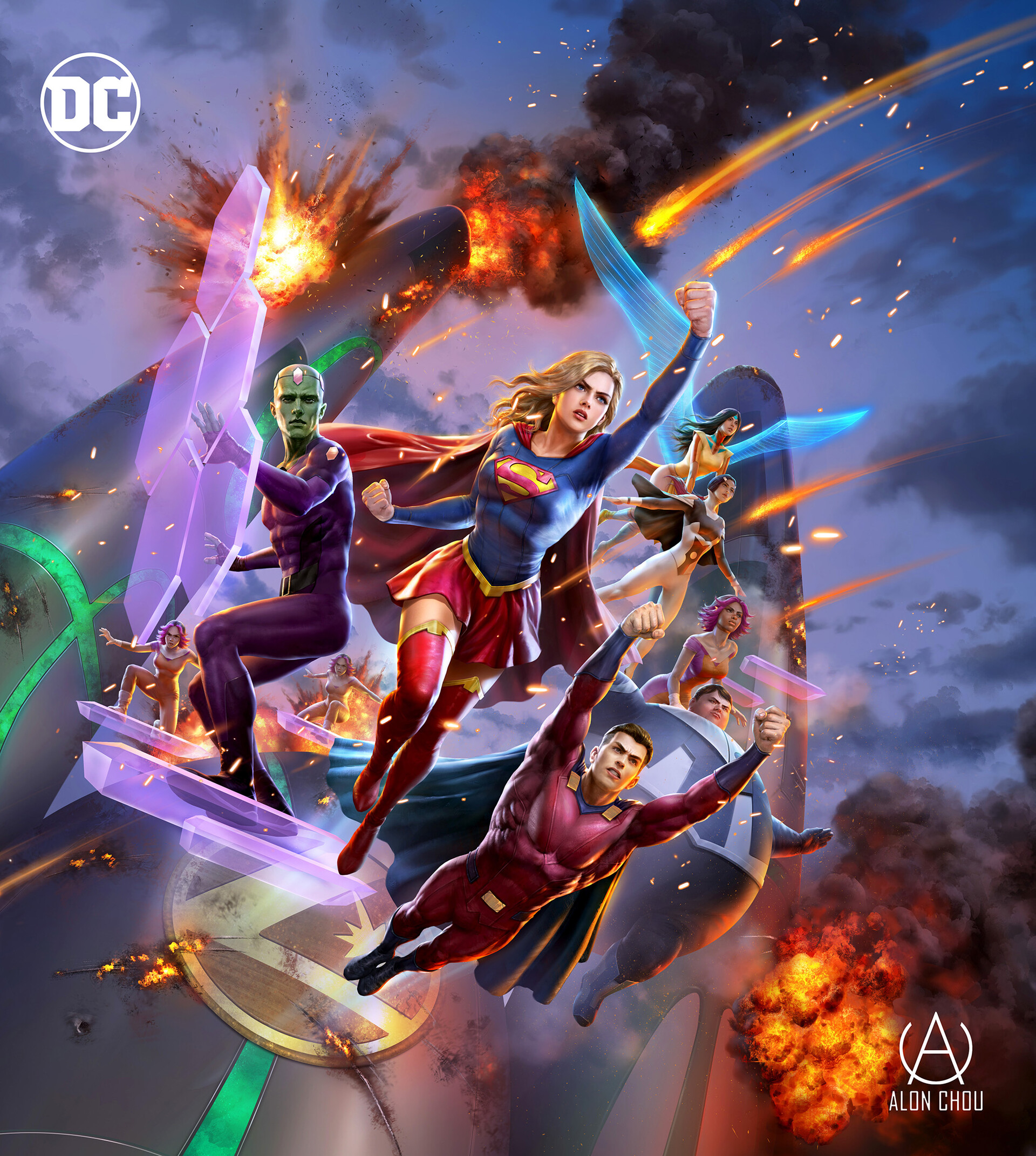
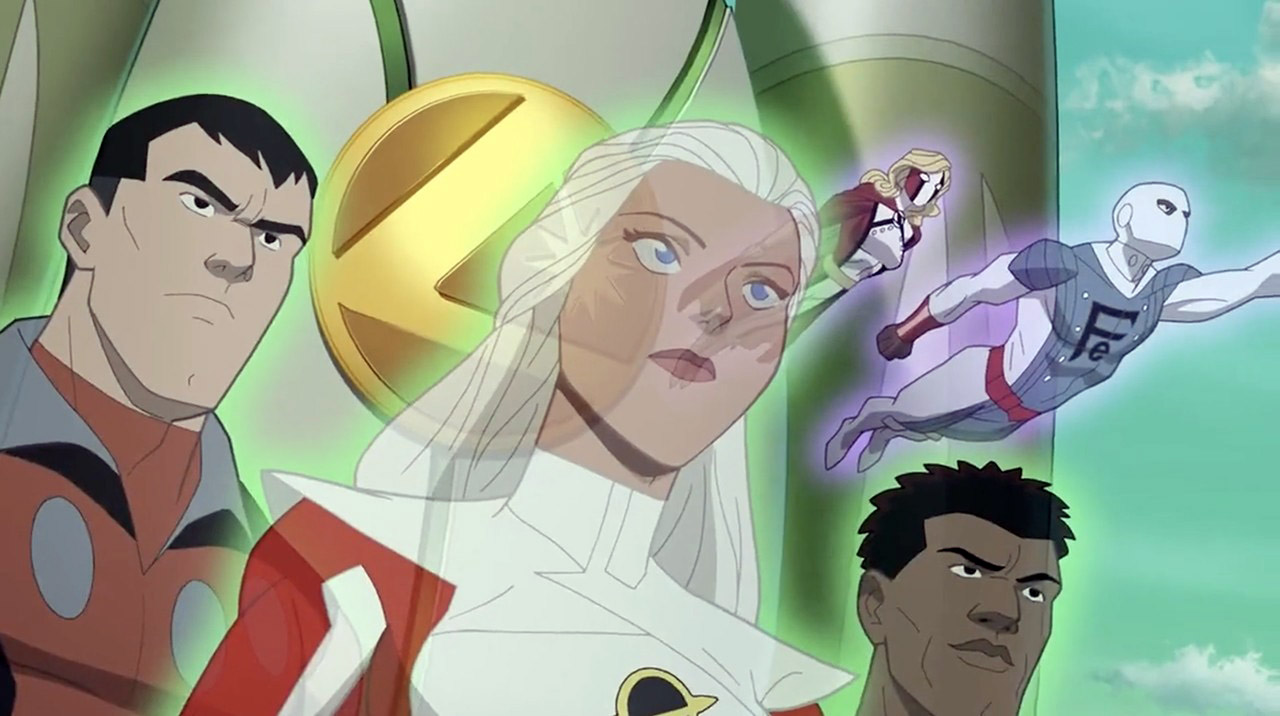

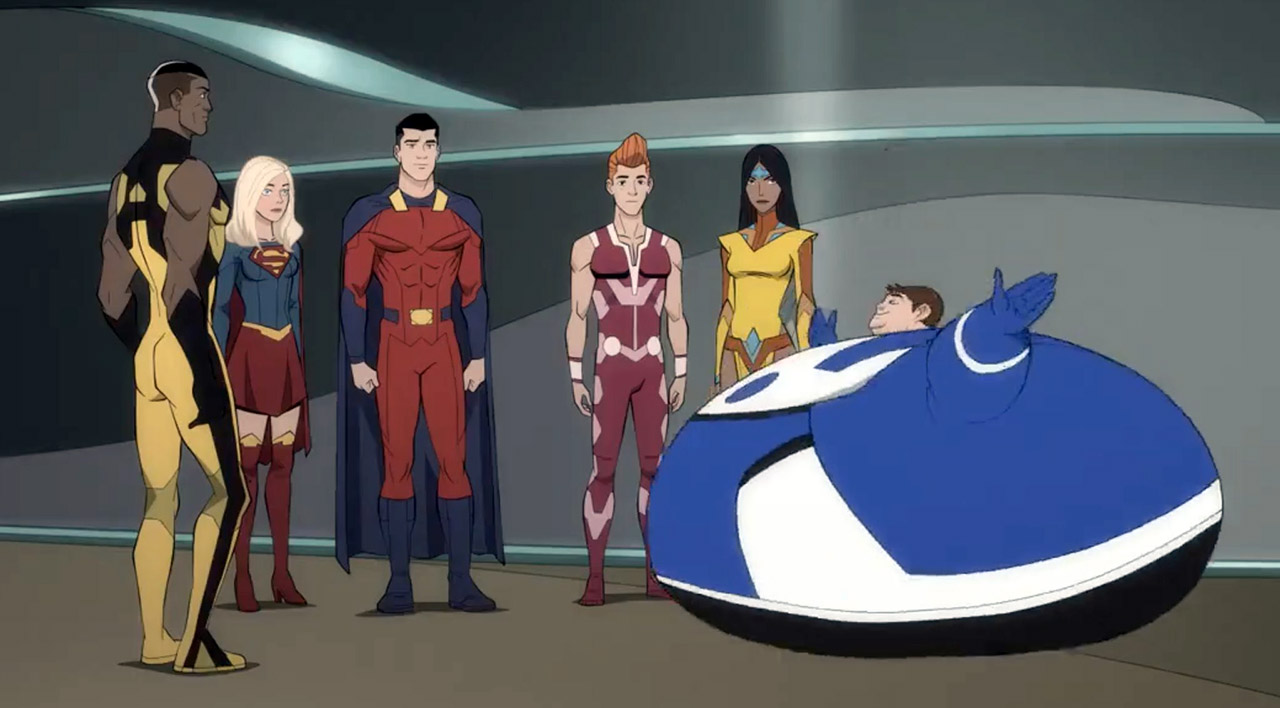
In this animated feature, Superman uses a time sphere to introduce Supergirl to Legion of Super-Heroes in the 31st century. She joins the Legion Academy at a time when most Legionnaires have been captured by the Dark Circle.
Her fellow Acadamy member, Mon-El, turns out to be a spy for the Circle and Supergirl and Brainiac 5 are key in leading the Academy to take them down.
When the Legionnaires return, they decide to admit all of the Academy students to full-time status.
The Legion of this feature is an amalgamation of all Legion incarnations, and includes members from different realities/eras, some who were never official members in the comic books.
Roll Call, the Legion Academy (the main characters in the movie):
- Arms-Fall-Off Boy
- Brainiac 5
- Bouncing Boy
- Dawnstar
- Invisible Kid
- Mon-El
- Phantom Girl
- Quislet
- Stone Boy
- Supergirl
- Triplicate Girl/Duplicate Girl
Roll Call, the Legionnaires:
- Andromeda
- Atmos
- Blok
- Catspaw
- Chameleon Boy
- Chemical King
- Color Kid
- Comet Queen
- Cosmic Boy
- Dream Girl
- Element Lad
- Ferro Lad
- Gates
- Gold Lantern
- Karate Kid
- Kid Quantum
- Kinetix
- Lightning Lad
- Monstress
- Polar Boy
- Power Boy
- Saturn Girl
- Sensor Girl
- Shadow Lass
- Star Boy
- Tellus
- Timber Wolf
- Tyroc
- Wildfire